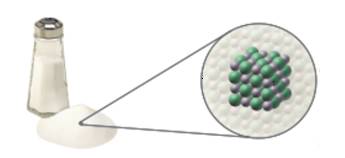
Concept explainers
Consider the photograph and illustrations of table salt. Do they include a model? Do they include a depiction of matter at the macroscopic, microscopic, and/or particulate levels? Explain your answers.

To predict the given photograph and illustrations of table salt, identify the depiction of matter at the macroscopic, microscopic, and/or particulate levels with explanation.
Interpretation:
Macroscopic, microscopic and particulate forms of matter are the three forms of matter.
Macroscopic can be viewed by the naked eyes, but we will be able to view microscopic form only by an optical microscope or electron microscope. Matter at the particulate level is so small that even with electron microscope it is really very difficult see them. Scientist use model to understand matter at particulate level. Models is representation of something
Concept introduction:
Answer to Problem 2.1TC
The art depicts a model of table salt at the particulate level. The photograph shows the macroscopic level
Explanation of Solution
Macroscopic, microscopic and particulate forms of matter are the three forms of matter.
Macroscopic can be viewed by the naked eyes, but we will be able to view microscopic form only by an optical microscope or electron microscope. Matter at the particulate level is so small that even with electron microscope it is really very difficult see them. Scientist use model to understand matter at particulate level. Models are representation of something. From the above statement we can say that the art depicts a model of table salt at the particulate level. The photograph shows at the macroscopic level
Thus the art depicts a model of table salt at the particulate level. The photograph shows the macroscopic level
Want to see more full solutions like this?
Chapter 2 Solutions
Introductory Chemistry: An Active Learning Approach
- Suggest a reason for studying matter at the particulate level, given that it is too small to see.arrow_forwardPotassium sulfate has a solubility of 15 g/ 100 g water at 40C. A solution is prepared by adding 39.0 g of potassium sulfate to 225 g of water, carefully heating the solution, and cooling it to 40C. A homogeneous solution is obtained. Is this solution saturated, unsaturated, or supersaturated? The beaker is shaken, and precipitation occurs. How many grams of potassium sulfate would you expect to crystallize out?arrow_forwardSome scientists think there are living things smaller than bacteria (New York Times, January 18, 2000, p. D1). Called nanobes, they are roughly cylindrical and range from 20 to 150 nm long and about 10 nm in diameter. One approach to determining whether nanobes are living is to estimate how many atoms and molecules could make up a nanobe. If the number is too small, then there would not be enough DNA, protein, and other biological molecules to carry out life processes. To test this method, estimate an upper limit for the number of atoms that could be in a nanobe. (Use a small atom, such as hydrogen.) Also estimate how many protein molecules could fit inside a nanobe. Do your estimates rule out the possibility that a nanobe could be living? Explain why or why not.arrow_forward
- Suppose someone emptied ball bearings into a container of salt. Could you separate the ball bearings from the salt? How? Would your method involve no change, be a physical change, or be a chemical change?arrow_forwardSuppose that you are closing a cabin in the north woods for the winter and you do not want the water in the toilet tank to freeze. You know that the temperature might get as low as 30. C, and you want to protect about 4.0 L water in the toilet tank from freezing. Calculate the volume of ethylene glycol (density = 1.113 g/mL; molar mass = 62.1 g/mol) you should add to the 4.0 L water.arrow_forwardA white, crystalline material that looks like table salt gives off a gas when heated under certain conditions. There is no change in the appearance of the solid that remains, but it does not taste the same as it did originally. Was the beginning material an element or a compound? Explain your answer.arrow_forward
- Hexane (C6H14, density = 0.766 g/cm3), perfluoro-hexane (C6F14, density = 1.669 g/cm3), and water are immiscible liquids; that is, they do not dissolve in one another. You place 10 mL of each in a graduated cylinder, along with pieces of high-density polyethylene (HDPE, density = 0.97 g/cm3), polyvinyl chloride(PVC, density = 1.36 g/cm3), and Teflon (density = 2.3 g/cm3). None of these common plastics dissolves in these liquids. Describe what you expect to see.arrow_forwardIn Figure 1.5 you see macroscopic and particulate views of the element bromine. Which are the macroscopic views and which are the particulate views? Describe how the particulate views explain properties of this element related to the state of matter.arrow_forwardOne student measured 25 cm3 of a 1.06 g / dm3 sodium carbonate solution. Calculate the mass of sodium carbonate in mg present in the measured volume.arrow_forward
 Introductory Chemistry: An Active Learning Approa...ChemistryISBN:9781305079250Author:Mark S. Cracolice, Ed PetersPublisher:Cengage Learning
Introductory Chemistry: An Active Learning Approa...ChemistryISBN:9781305079250Author:Mark S. Cracolice, Ed PetersPublisher:Cengage Learning Chemistry: The Molecular ScienceChemistryISBN:9781285199047Author:John W. Moore, Conrad L. StanitskiPublisher:Cengage LearningChemistry: Matter and ChangeChemistryISBN:9780078746376Author:Dinah Zike, Laurel Dingrando, Nicholas Hainen, Cheryl WistromPublisher:Glencoe/McGraw-Hill School Pub Co
Chemistry: The Molecular ScienceChemistryISBN:9781285199047Author:John W. Moore, Conrad L. StanitskiPublisher:Cengage LearningChemistry: Matter and ChangeChemistryISBN:9780078746376Author:Dinah Zike, Laurel Dingrando, Nicholas Hainen, Cheryl WistromPublisher:Glencoe/McGraw-Hill School Pub Co Chemistry: Principles and ReactionsChemistryISBN:9781305079373Author:William L. Masterton, Cecile N. HurleyPublisher:Cengage Learning
Chemistry: Principles and ReactionsChemistryISBN:9781305079373Author:William L. Masterton, Cecile N. HurleyPublisher:Cengage Learning Chemistry & Chemical ReactivityChemistryISBN:9781133949640Author:John C. Kotz, Paul M. Treichel, John Townsend, David TreichelPublisher:Cengage Learning
Chemistry & Chemical ReactivityChemistryISBN:9781133949640Author:John C. Kotz, Paul M. Treichel, John Townsend, David TreichelPublisher:Cengage Learning Chemistry & Chemical ReactivityChemistryISBN:9781337399074Author:John C. Kotz, Paul M. Treichel, John Townsend, David TreichelPublisher:Cengage Learning
Chemistry & Chemical ReactivityChemistryISBN:9781337399074Author:John C. Kotz, Paul M. Treichel, John Townsend, David TreichelPublisher:Cengage Learning





